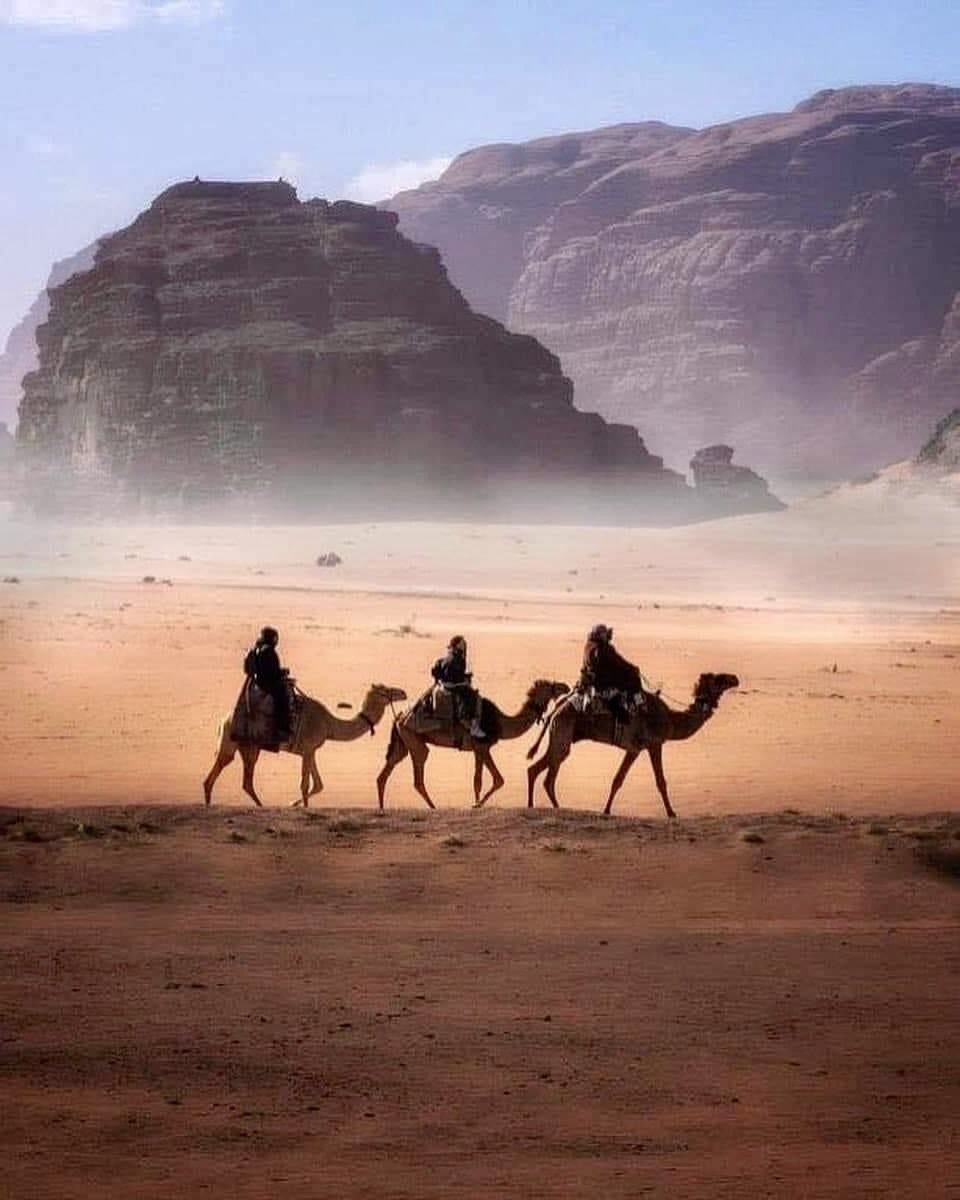I had heard the desert held a certain magic, but it wasn’t until I went there myself that I understood what people meant by that. Wadi Rum is a place that echoes with laughter by day and where you hear the void of the desert by night. It’s a place that matts your hair and stains your cheeks orange with dirt, but leaves you overwhelmingly happy at the end of the day. It’s a place where the earth glows red under the sun, and where you can gaze up the cylindrical spheres that twinkle in the midnight sky. It’s a place that T.E. Lawrence (better known as Lawrence of Arabia) described in his notes as “vast, echoing and God-like”, and it’s a place that I hope I can one day return to.
With scarves wrapped around our heads and sunglasses to shield our eyes from the sand, we hopped in the back of a Toyota pick-up truck and began our journey into “The Valley of the Moon”. Our first few days in Jordan had been spentexploring the ancient Greco-Roman ruins of Jerash, communing with nature in the Dana Nature Reserve, and reaching the Lost City of Petra, however, this, the wild untamed desert, felt like the Jordan I had been looking for all along.
Wadi Rum (Arabic: وادي رم ) is a protected wilderness area and UNESCO World Heritage Site situated in the south of Jordan. It is set on a high plateau at the western edge of the Arabian desert. Wadi Rum is a desert valley cut into sandstone and granite mountains, featuring a varied landscape of narrow canyons, towering cliffs, natural arches, inscriptions, rock carvings and archaeological remains. Wadi Rum was an outpost for nomadic Bedouins and caravans travelling on the ancient trade route between Saudi Arabia and Petra. Wadi Rum Protected Area was established in 1997 and named a UNESCO World Heritage site in 2011.
GEOGRAPHY OF WADI RUM
Wadi Rum is the product of millions of years of geological processes. The continual uplift, tectonic faulting, weathering and erosion have transformed the mountains of Wadi Rum into what we see today. Since early times, the natural landscape of Wadi Rum was the main source of life for Bedouins and their large herds of livestock. The only year-round water source for locals was freshwater springs near the eastern face of Jebel Rum, hence the development of Wadi Rum Village. The highest elevation in Jordan is Jebel Um Ad Dami at 1,840 m high, located in the south of the Protected Area, near the border with Saudi Arabia. On a clear day from the top, it is possible to see the Saudi desert, the Red Sea and the mountain ranges of the Sinai Peninsula, Egypt. Jebel Rum and Jebel Um Ishrin are the second and third tallest peaks, located on either side of Wadi Rum Village.
HISTORY
Wadi Rum has been inhabited by many human cultures since prehistoric times, including the Nabataeans. They left their mark in the form of petroglyphs, inscriptions and archaeological remains. Petroglyphs, representing humans and animals, are engraved on boulders, stones and cliff faces. Numerous inscriptions in different North Arabian scripts, Thamudic, Nabatean, Islamic and Arabic, evidence of an early emergence of alphabets and widespread literacy around pastoral societies in the Arabian Peninsula.
In the West, Wadi Rum is famous for its connection with British officer T.E. Lawrence, who travelled through Wadi Rum and the surrounding area several times during the Arab Revolt of 1917-18.
WADI RUM PROTECTED AREA
Wadi Rum Protected Area is a UNESCO World Heritage Site because of its remarkable natural beauty and cultural significance. The towering mountains, golden sand valleys, ancient petroglyphs and inscriptions make it stand out from the surrounding desert areas. The core history and magnificent scenery of Wadi Rum can be found within the Protected Area.
The vast Wadi Rum Desert and surrounding areas are divided by tribal land, and tribe members are responsible for running tourism activities and tours within their territory. The Zalabieh Tribe operate tours inside Wadi Rum Protected Area, based in Wadi Rum Village, the main hub of Wadi Rum. Other tribes, who have recently entered the tourism industry with the backing of Amman businessmen and building unlicensed camps, control the buffer zones, such as Disah and Shakriyyah.
THE ZALABIEH TRIBE
The Zalabieh Tribe is the prominent Bedouin community in Wadi Rum. Bedouins have a deep-rooted connection to the desert. Bedouin (Arabic: بَدْو) originates from the Arabic word badawī, which translates to ‘desert dwellers'. Their traditional way of life, steeped in nomadic heritage, has been preserved through the decades and passed down from generation to generation. Living in harmony with the desert, the Zalabieh Tribe embodies resilience, resourcefulness andan unmatched knowledge of the land.
The Zalabieh tribe is responsible for developing Wadi Rum into a tourist destination. They offer authentic desert experiences by organising tours, working as guides and owning camps. Many families have become semi-nomadic, embracing modernity and settling near schools and water resources, while others remain in the desert, living a nomadic lifestyle, often raising sheep, goats and camels. Bedouins lead a modest life with minimal belongings and what they need to survive in the desert and live in harmony with nature. Their culture and lifestyle make for an authentic and unforgettable desert experience.






































